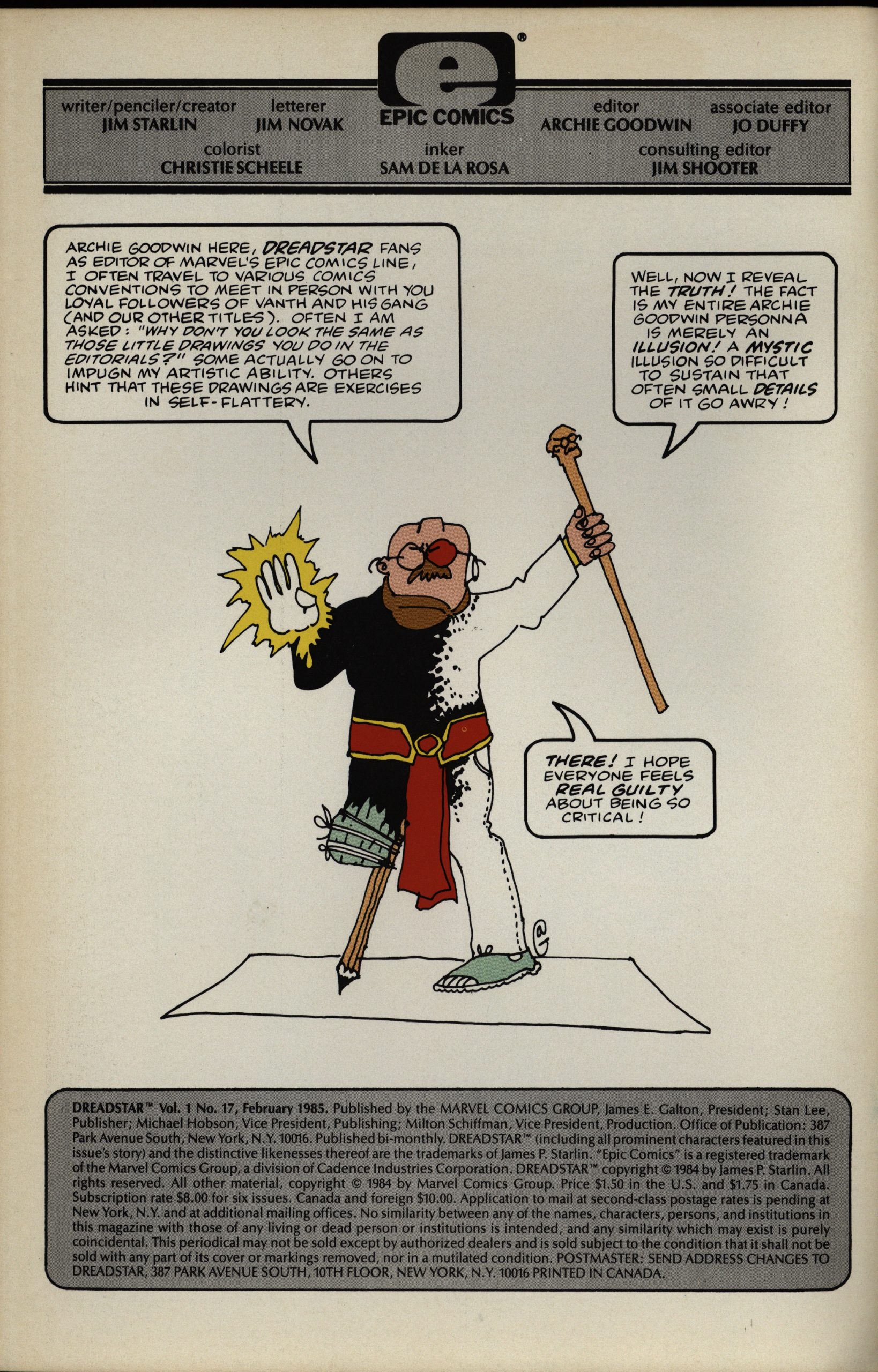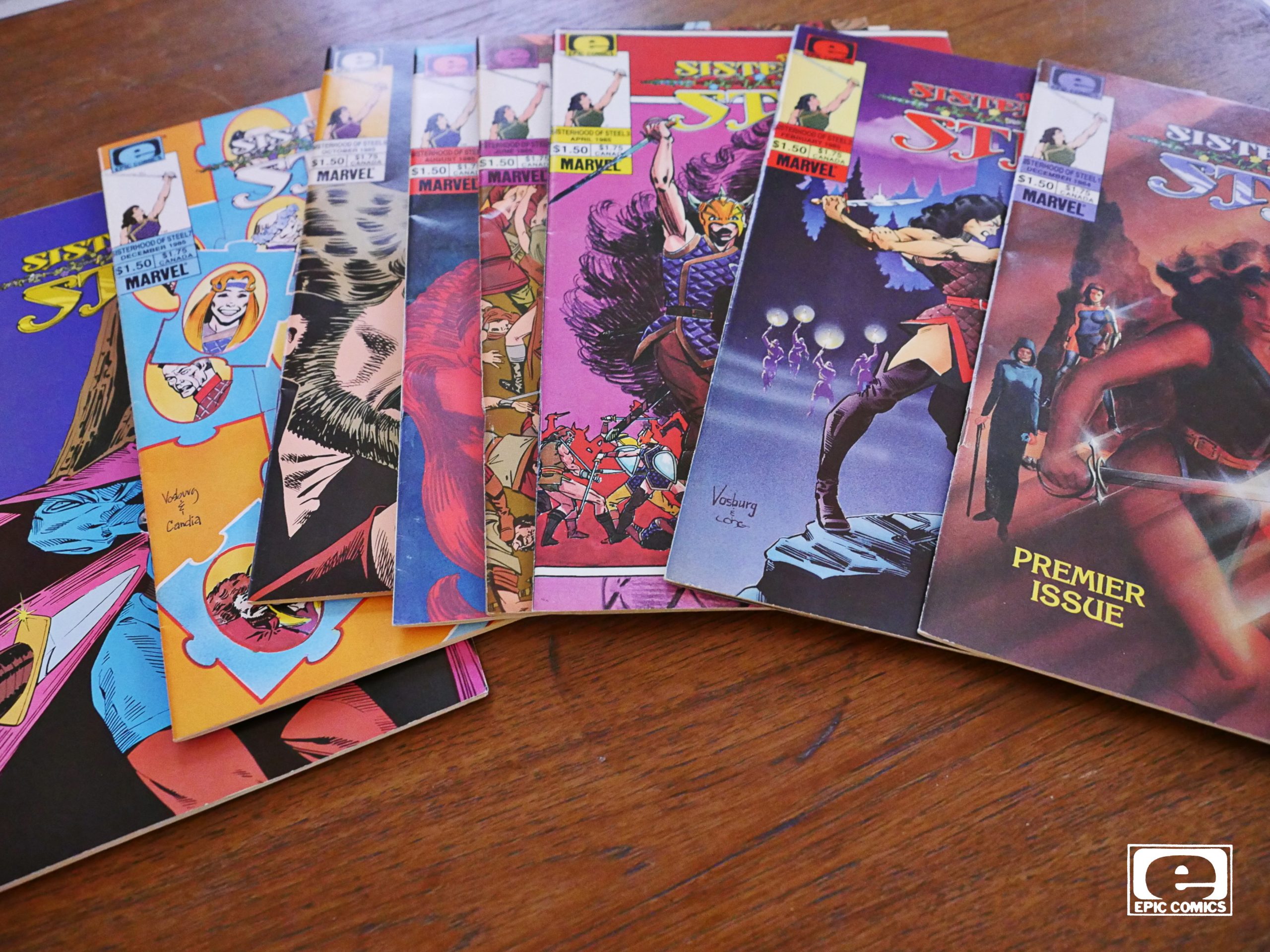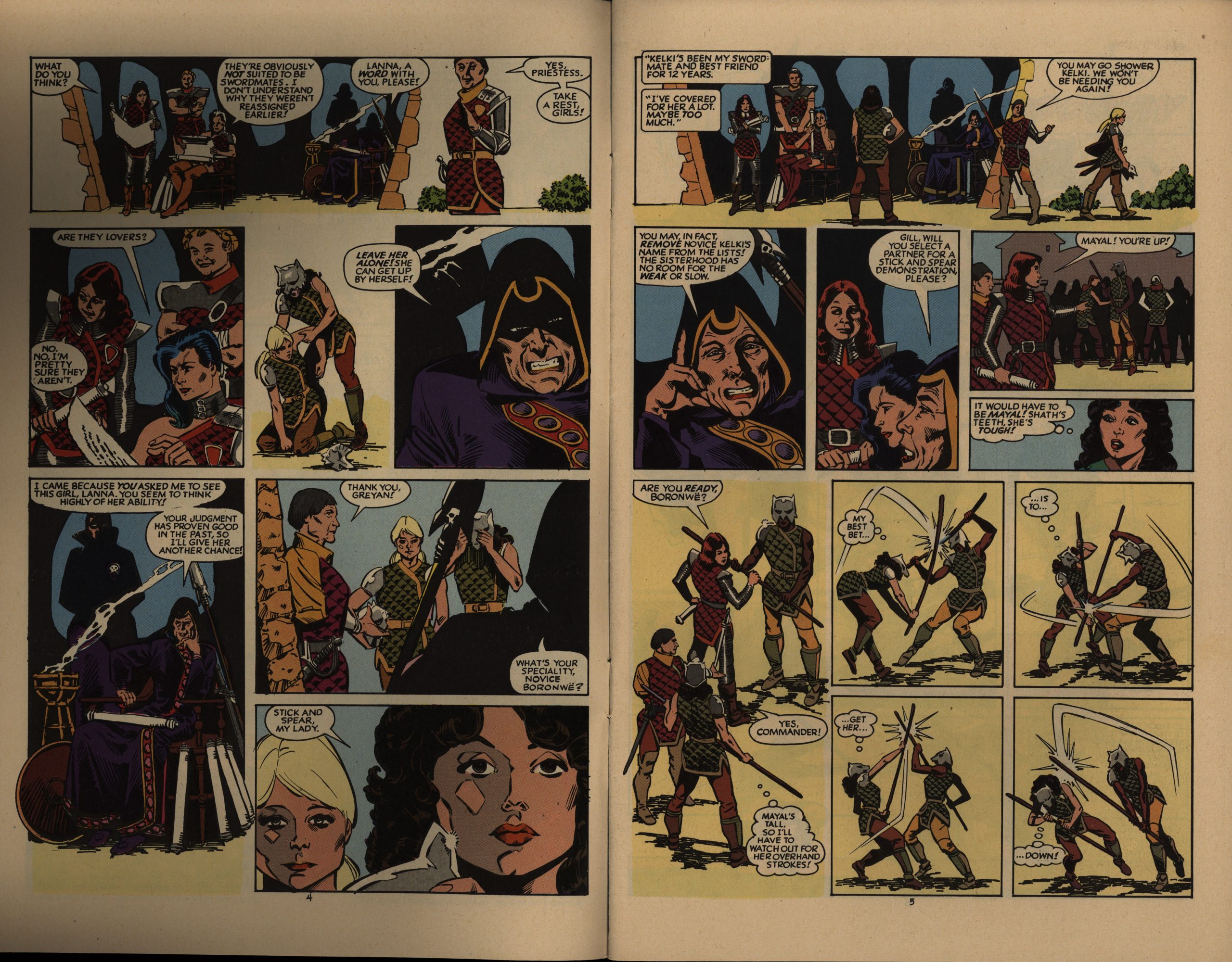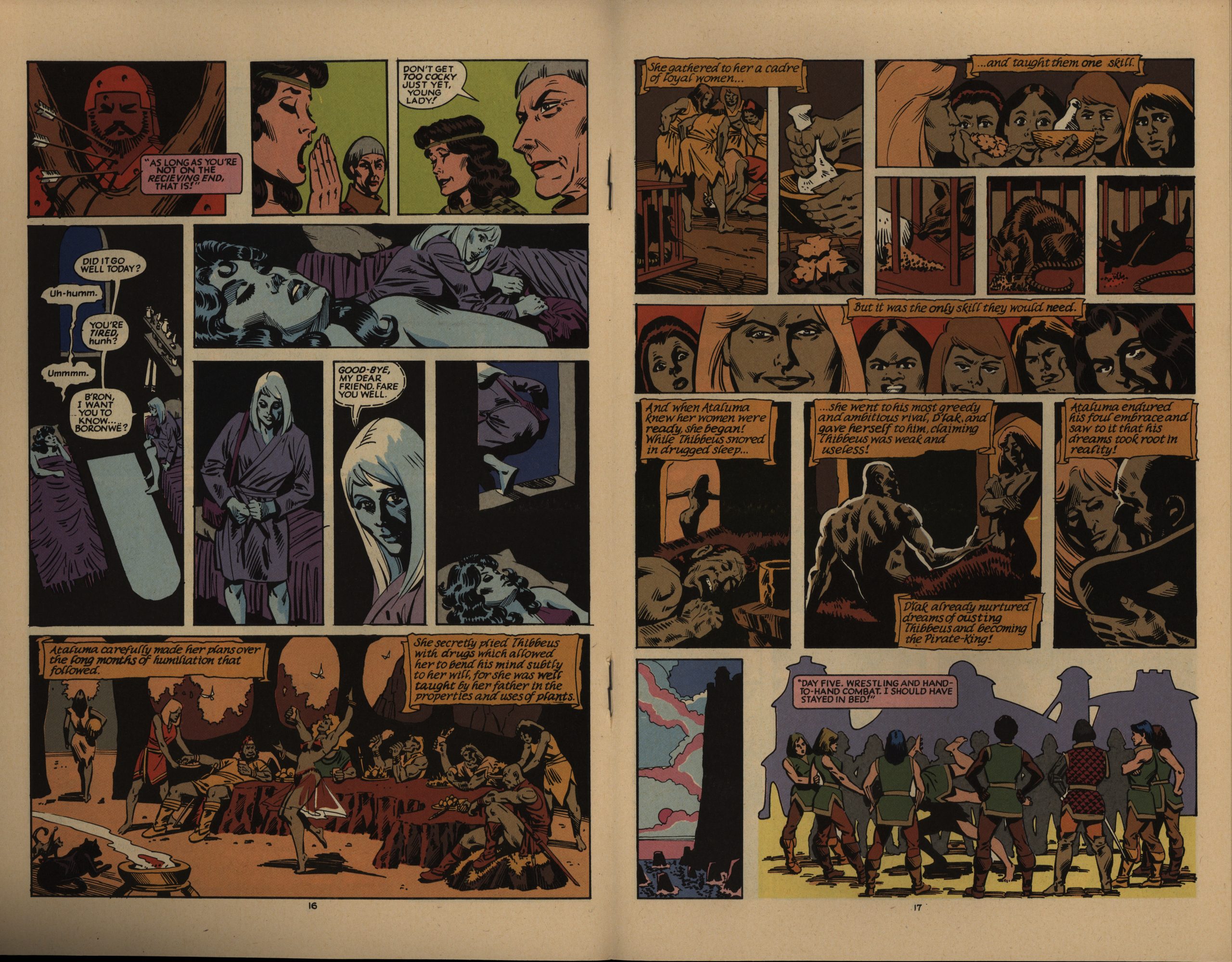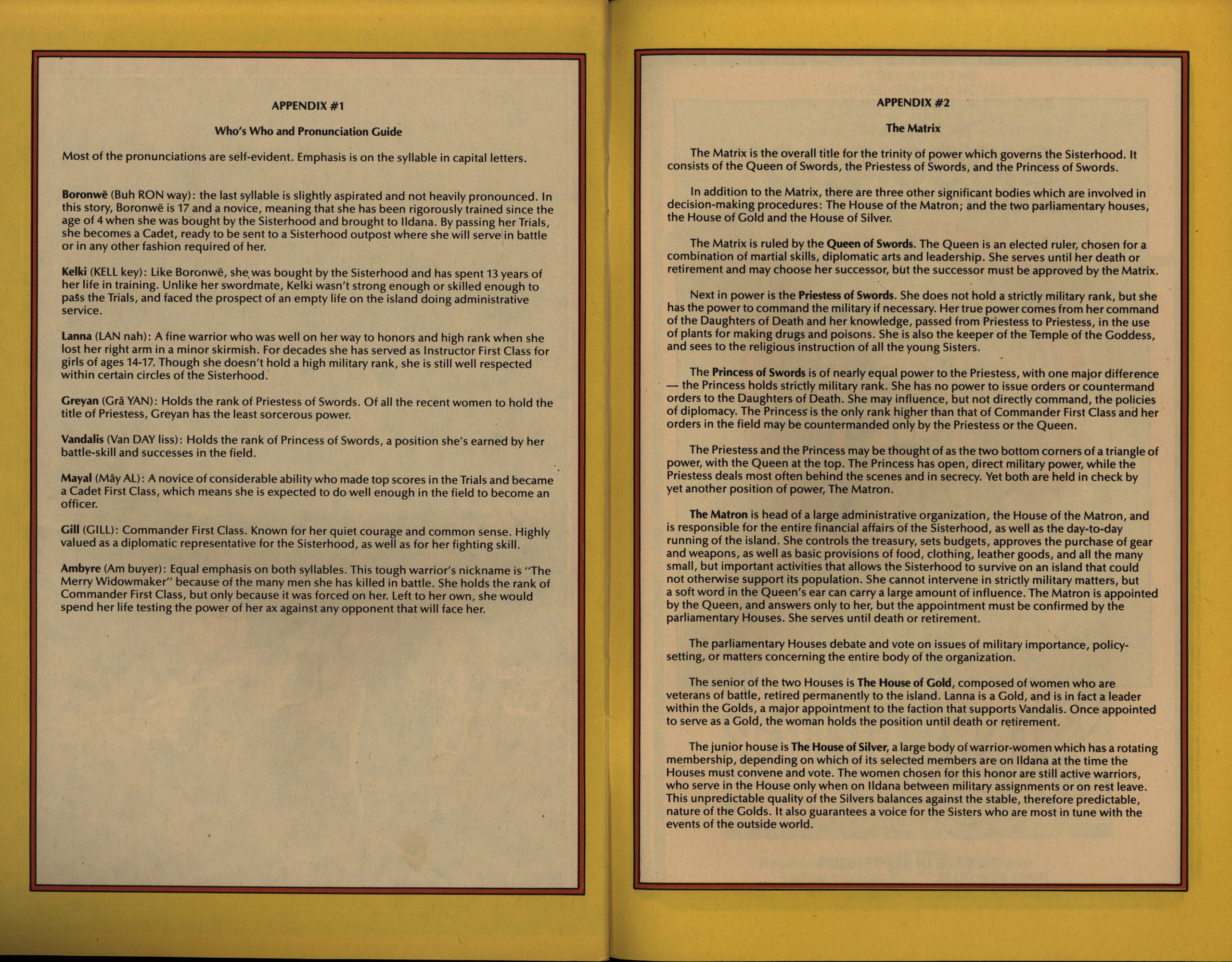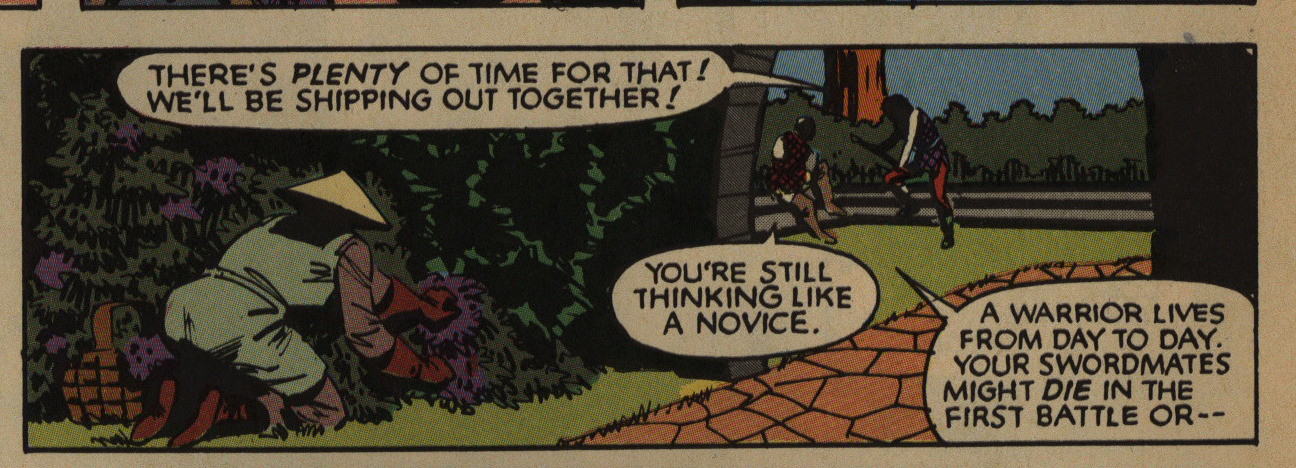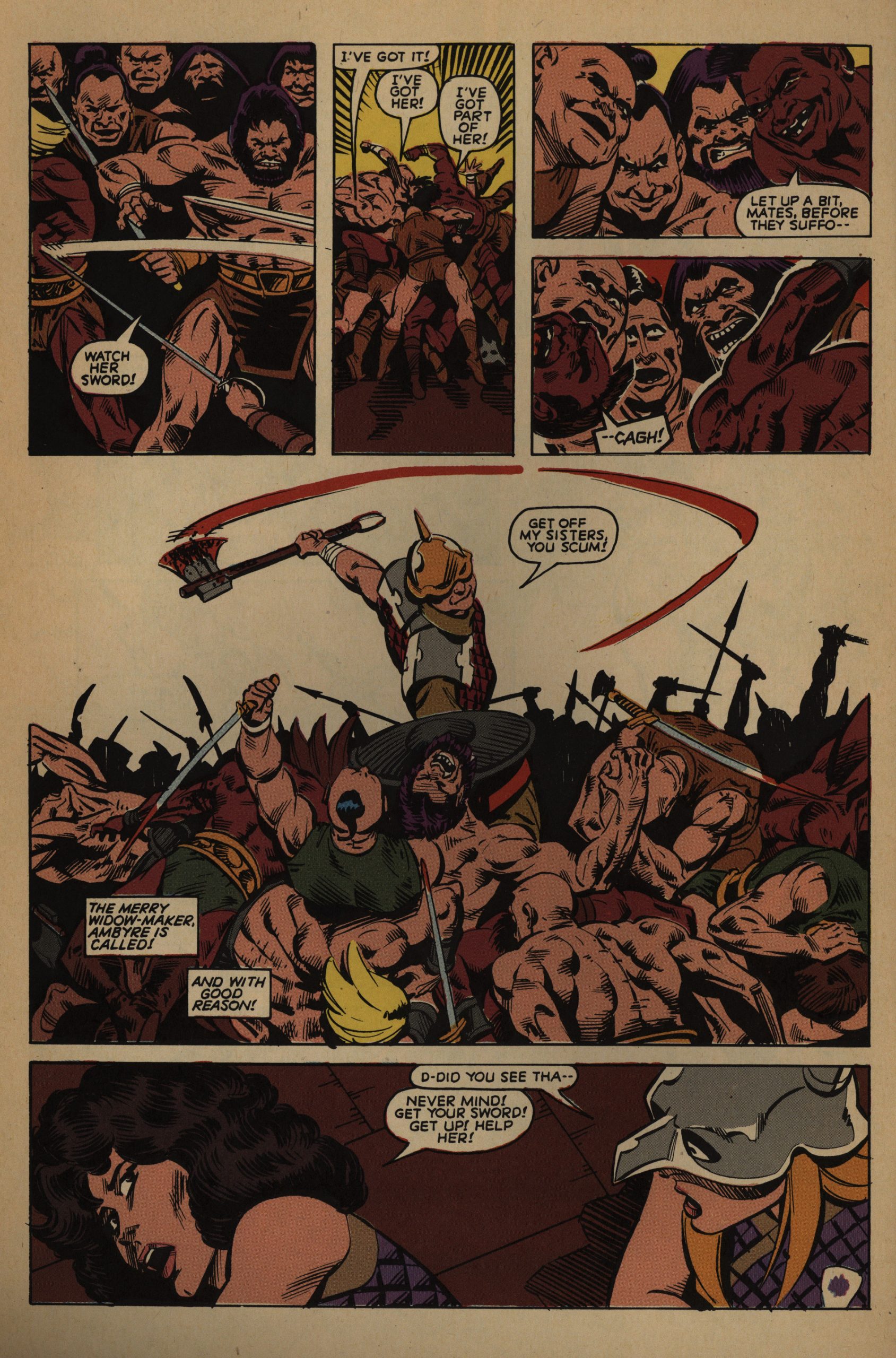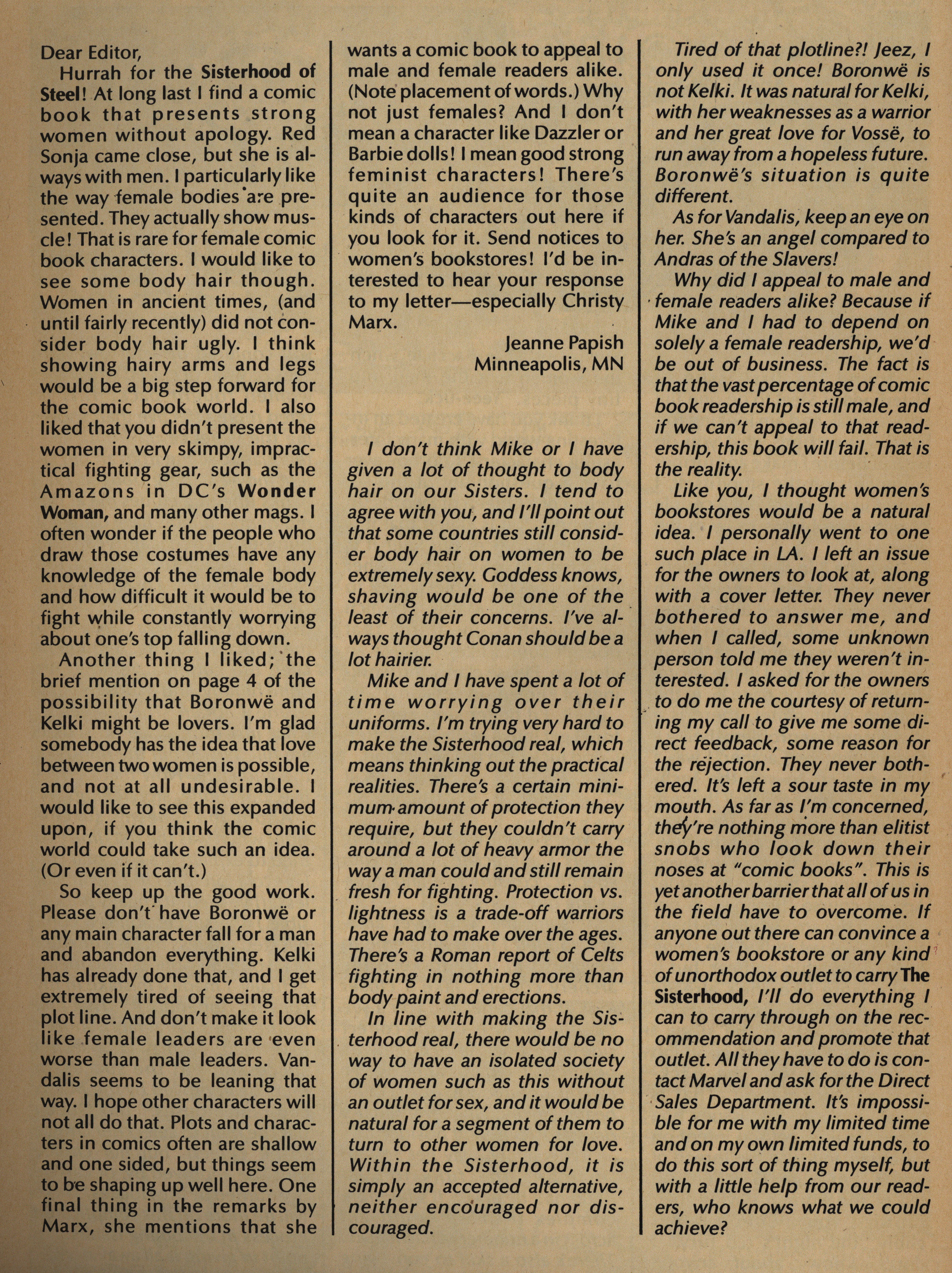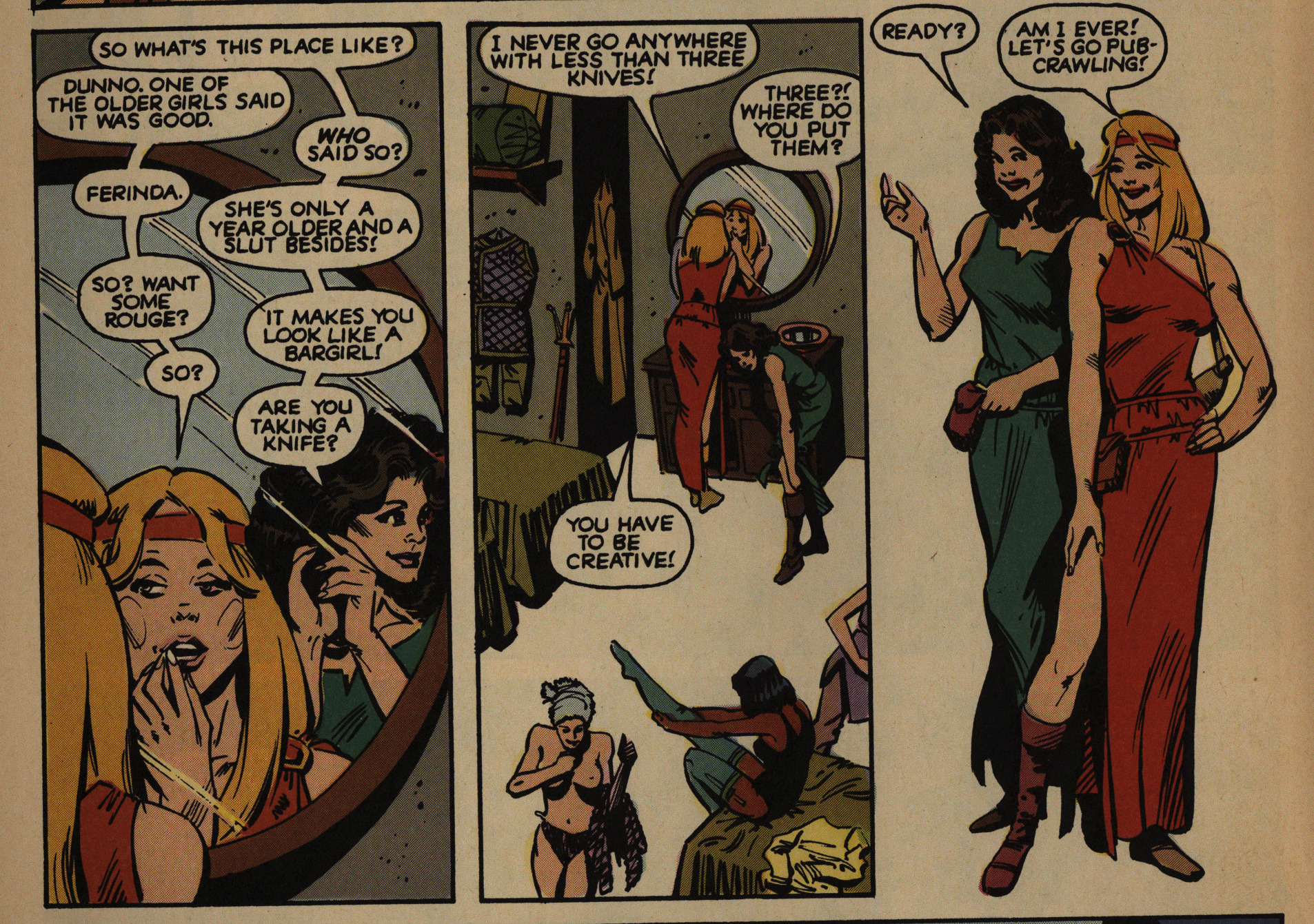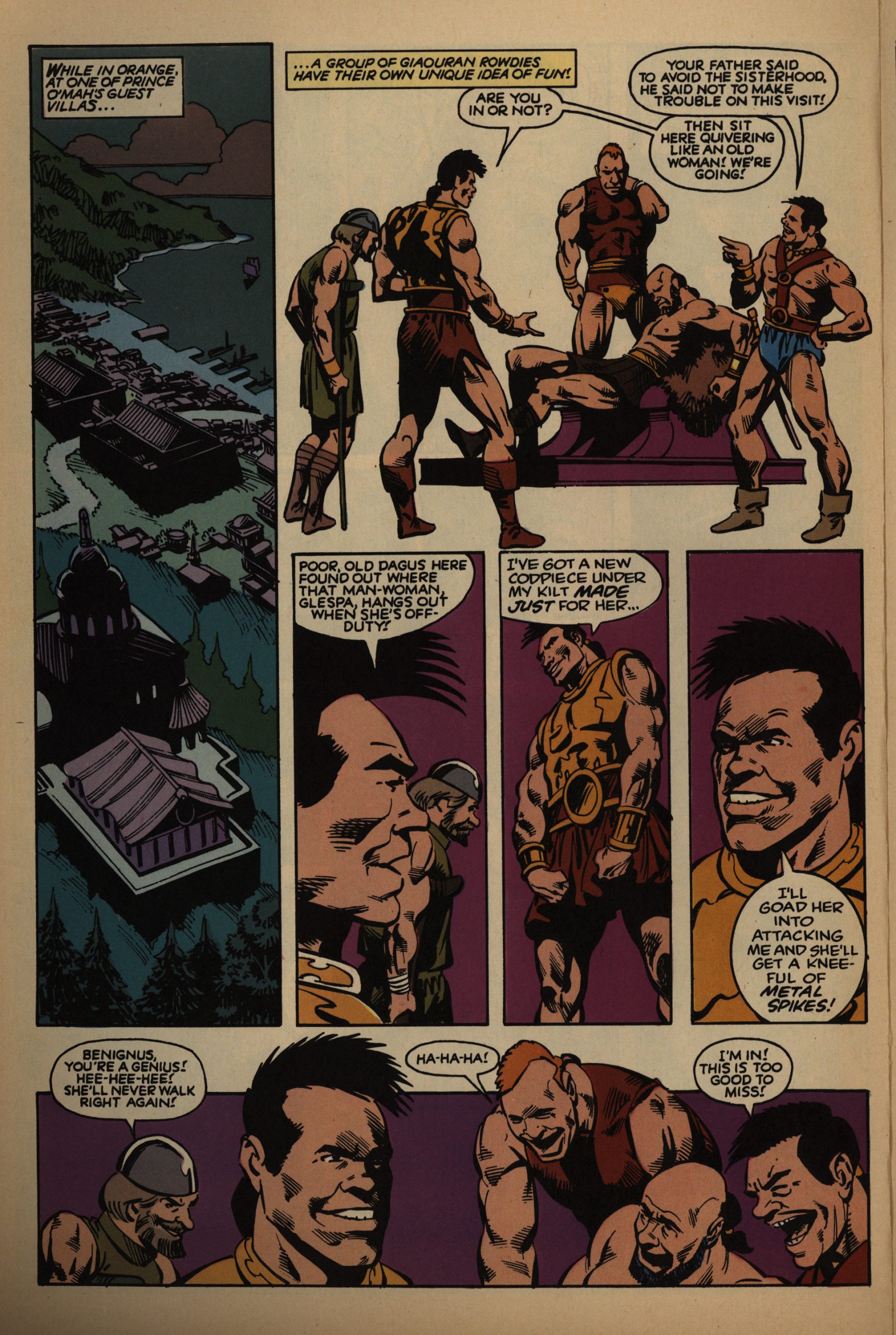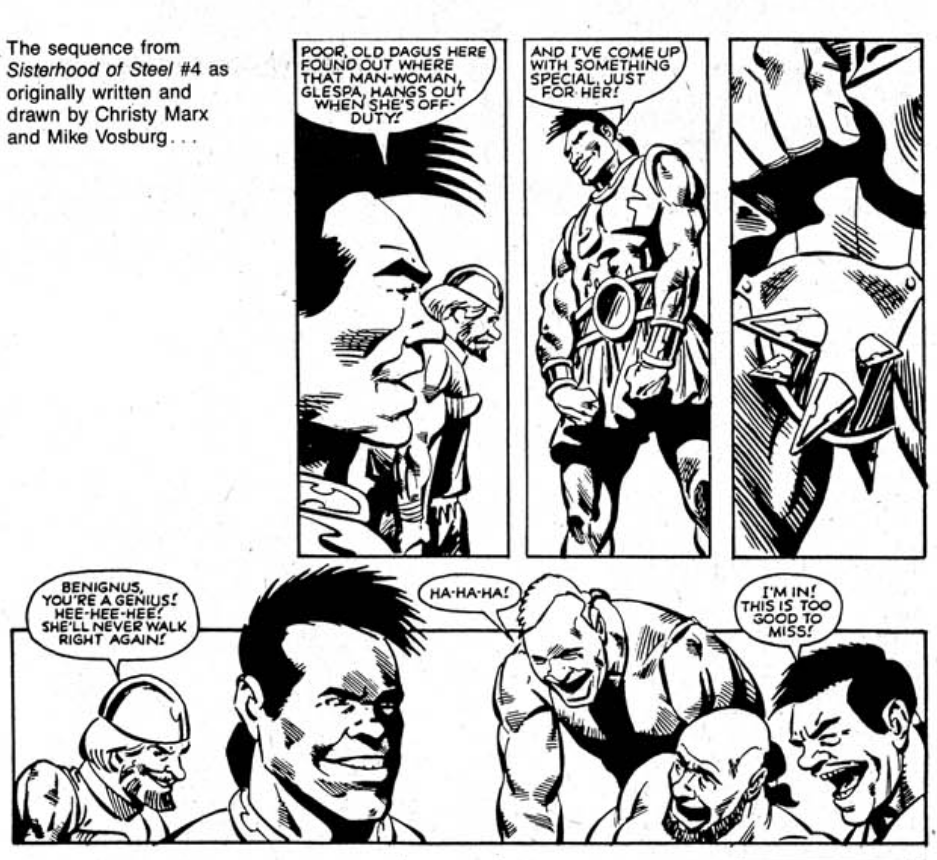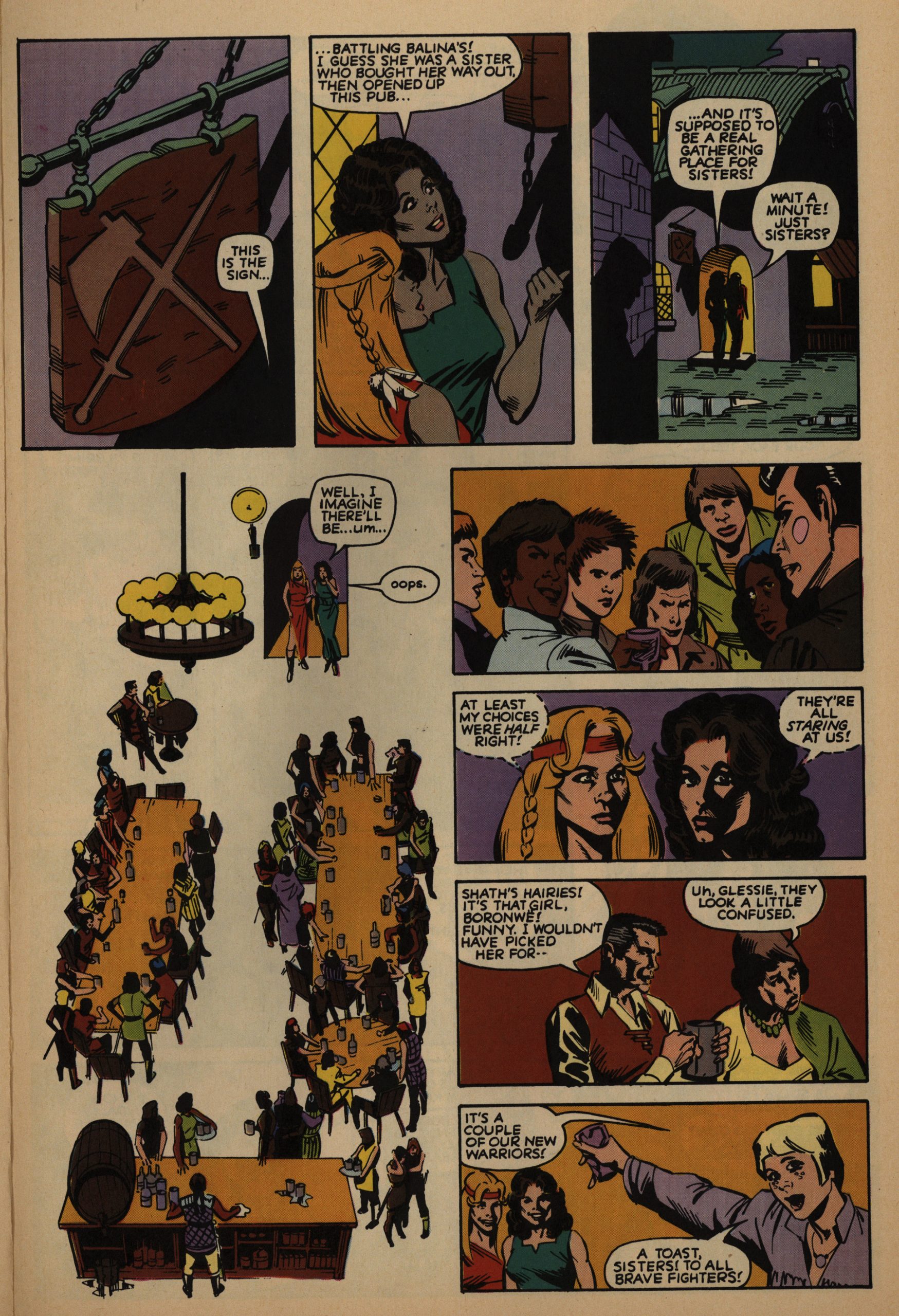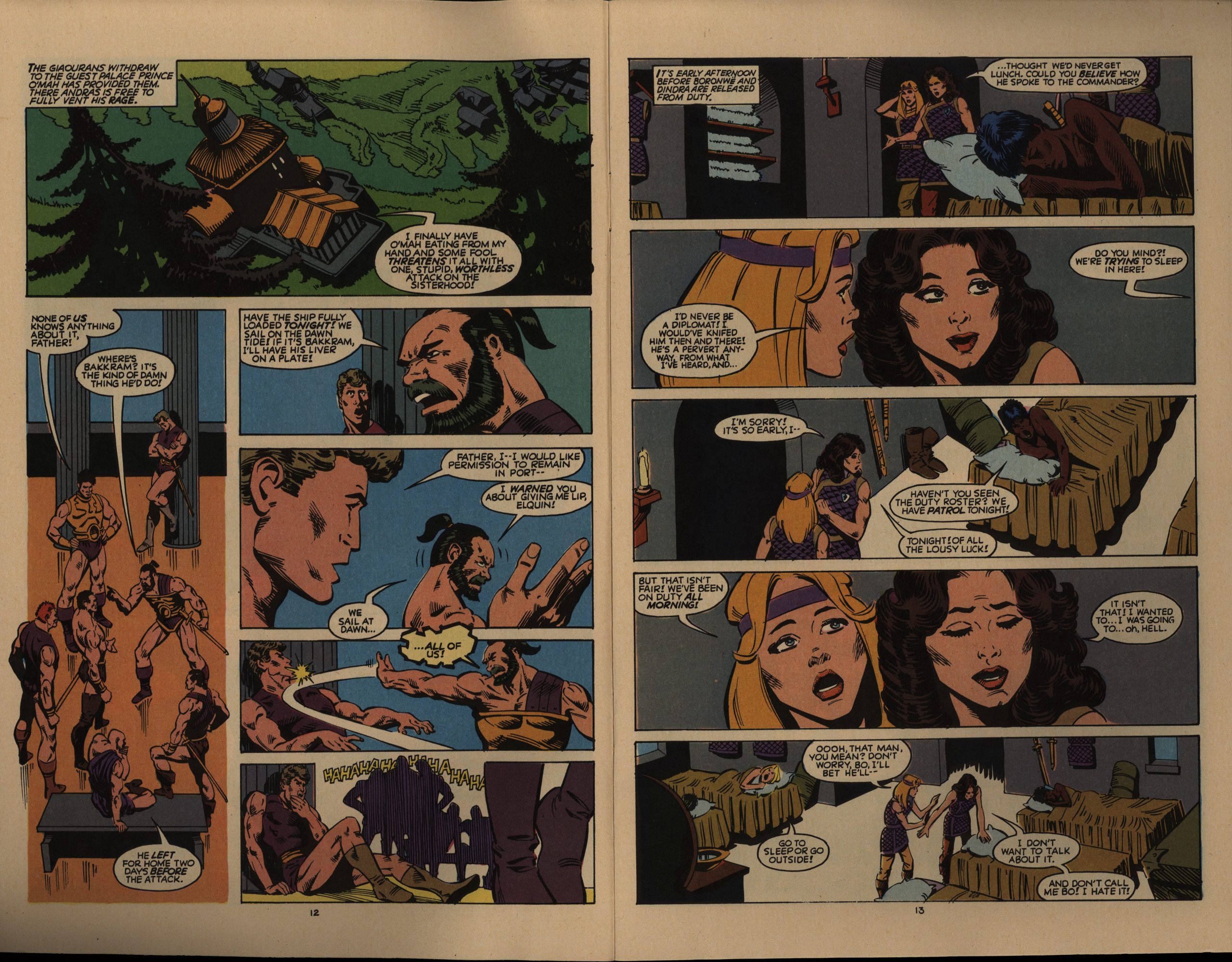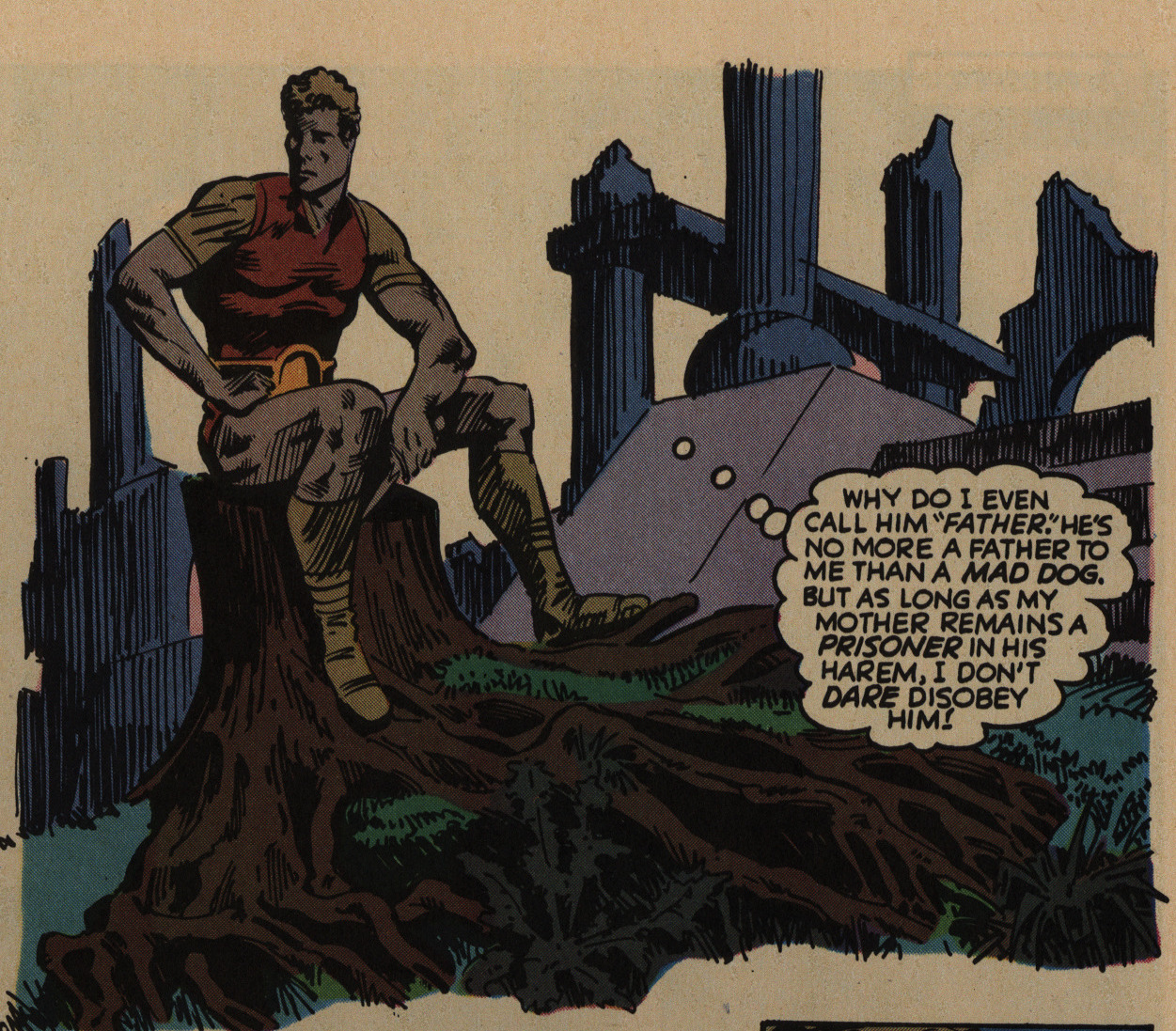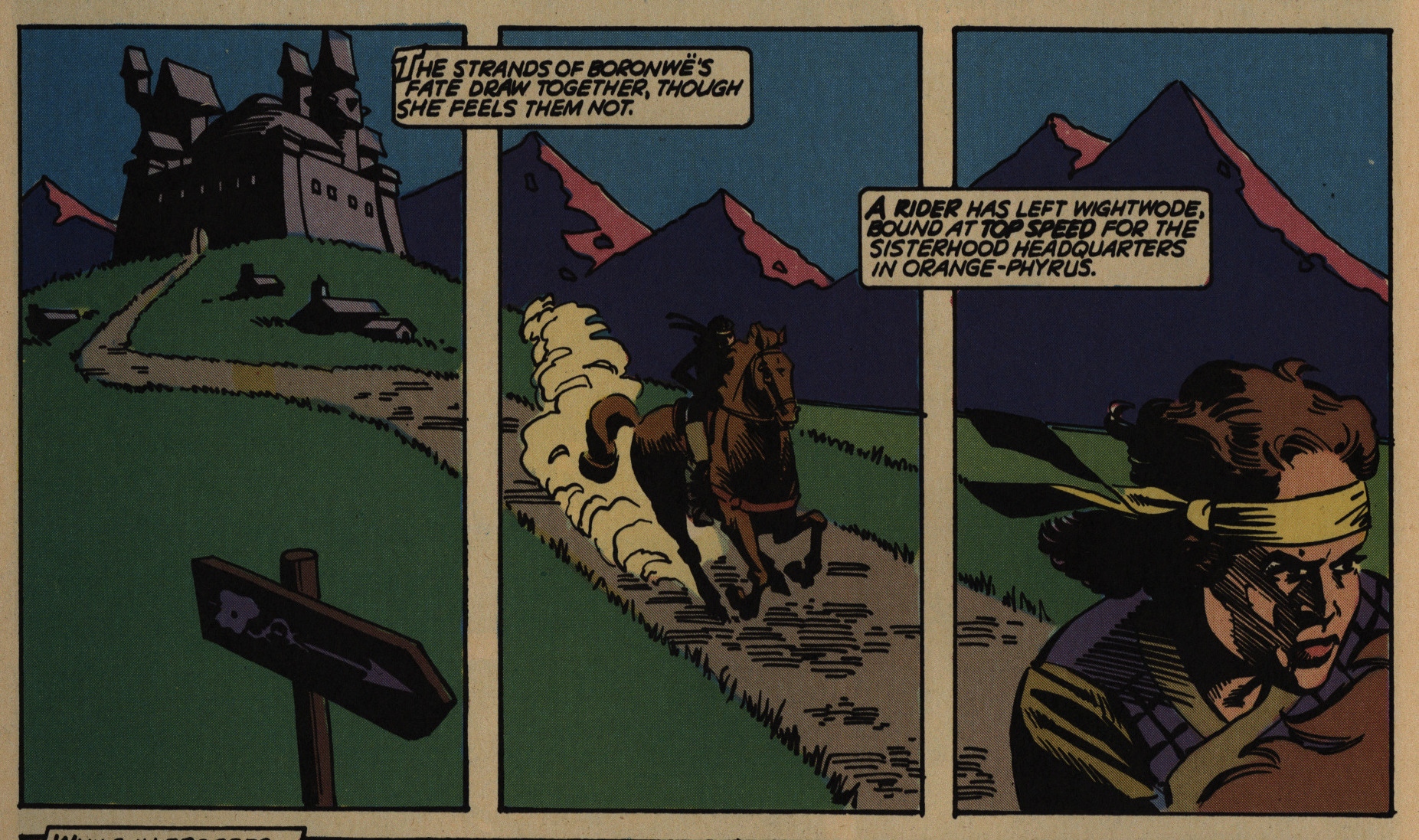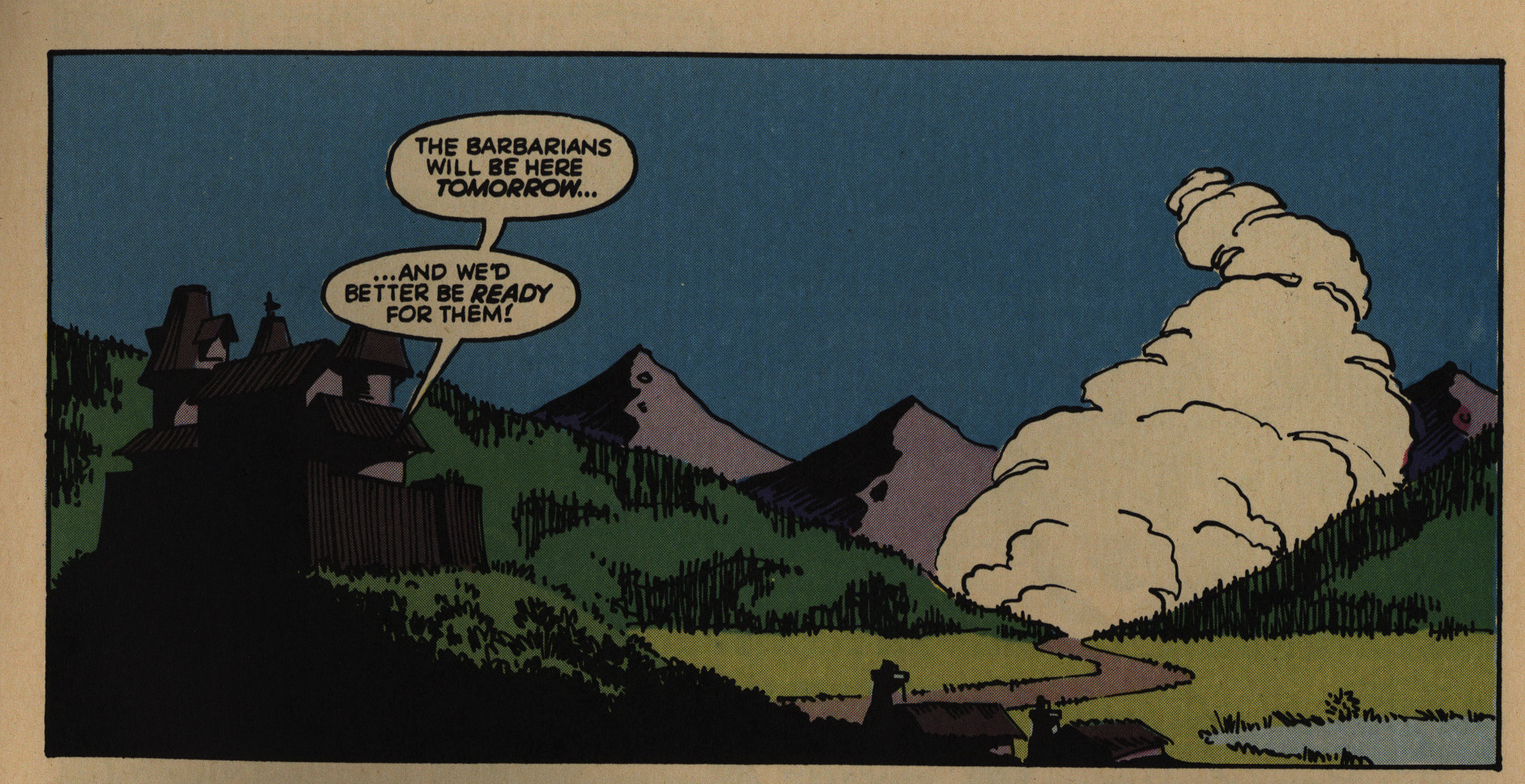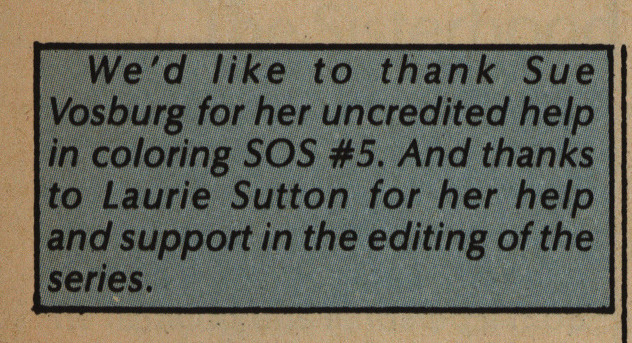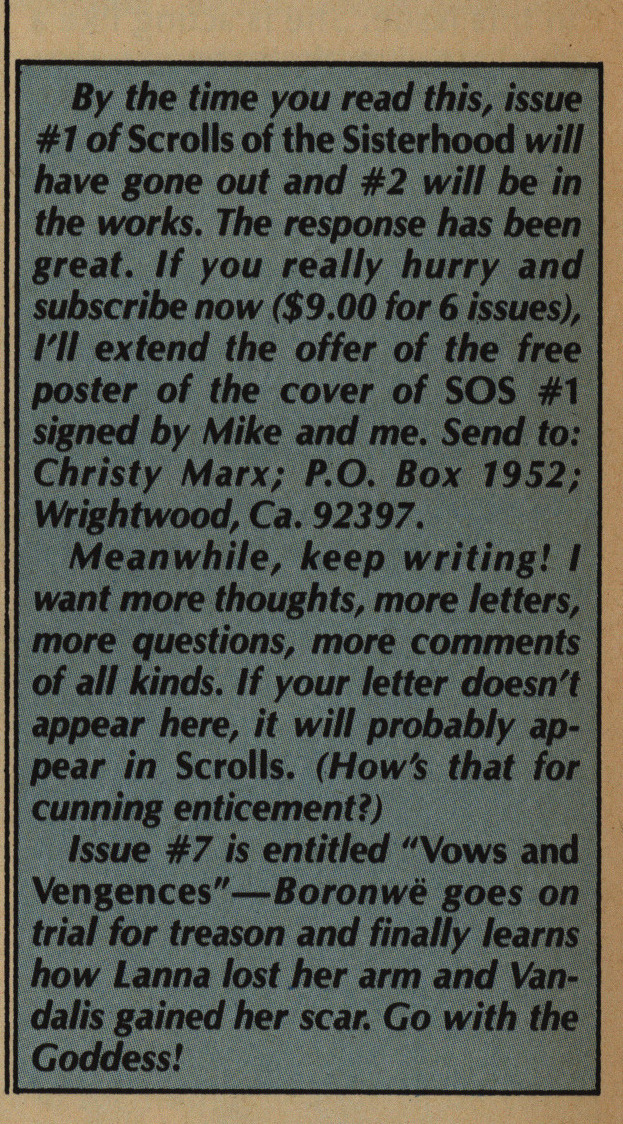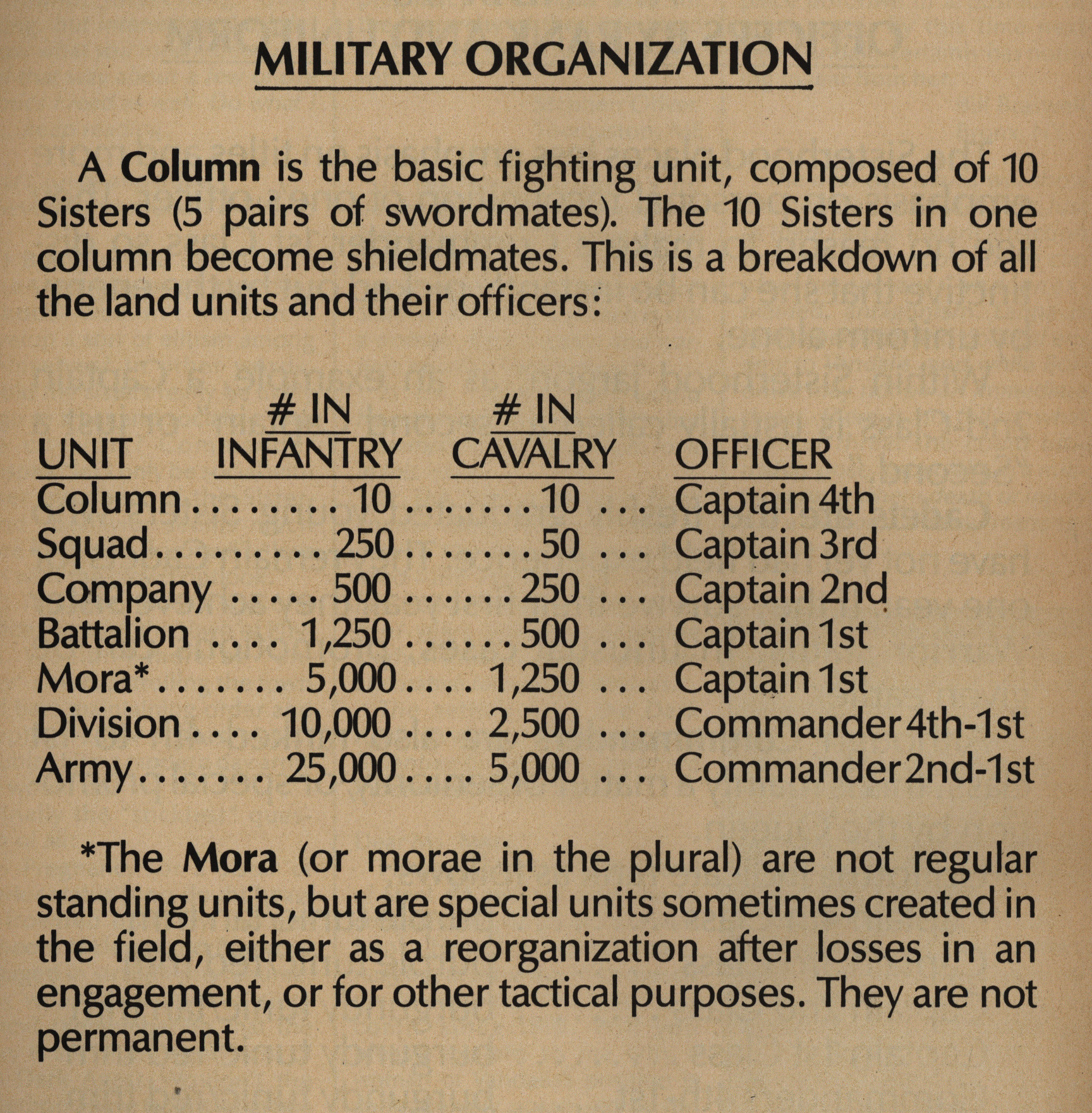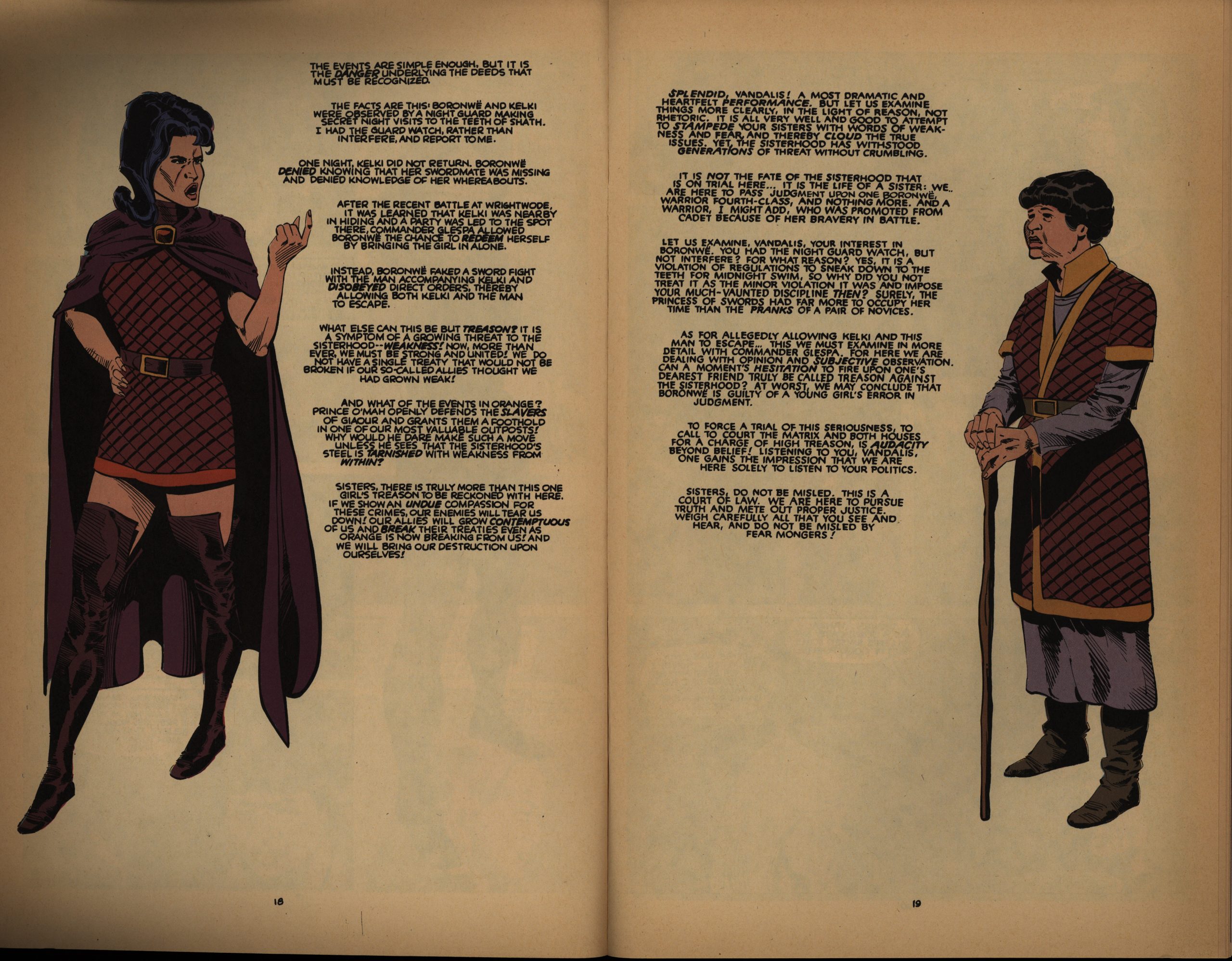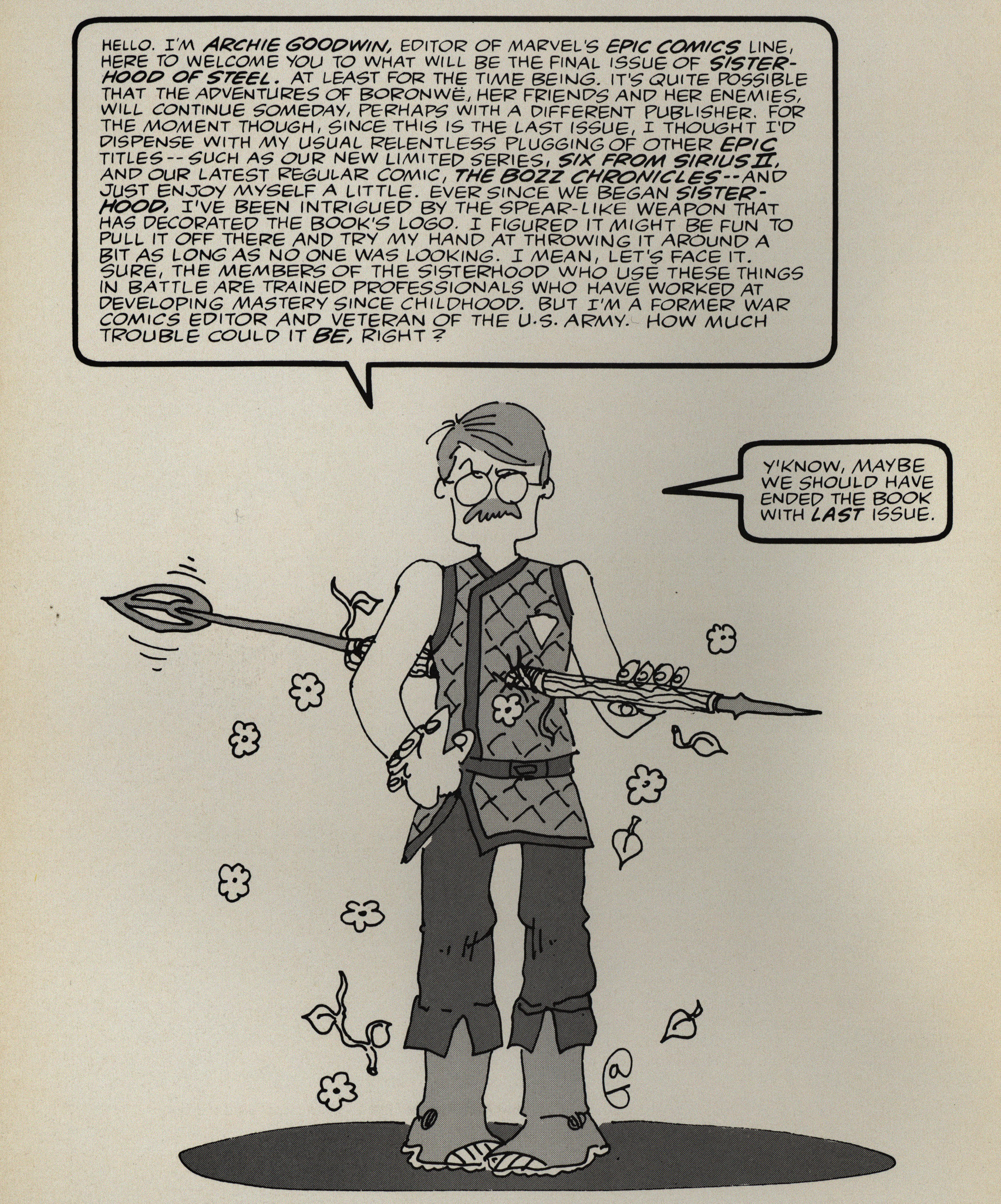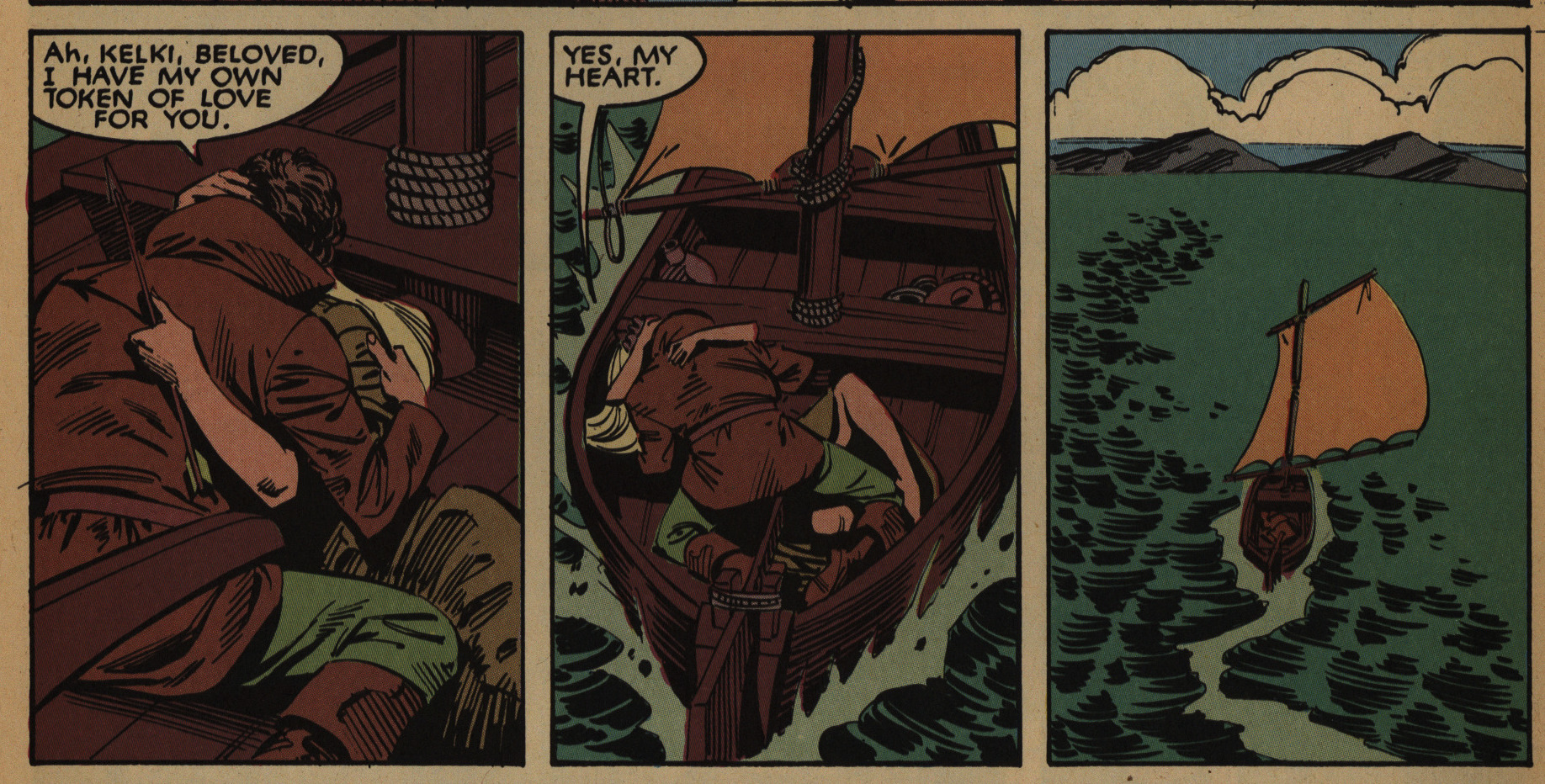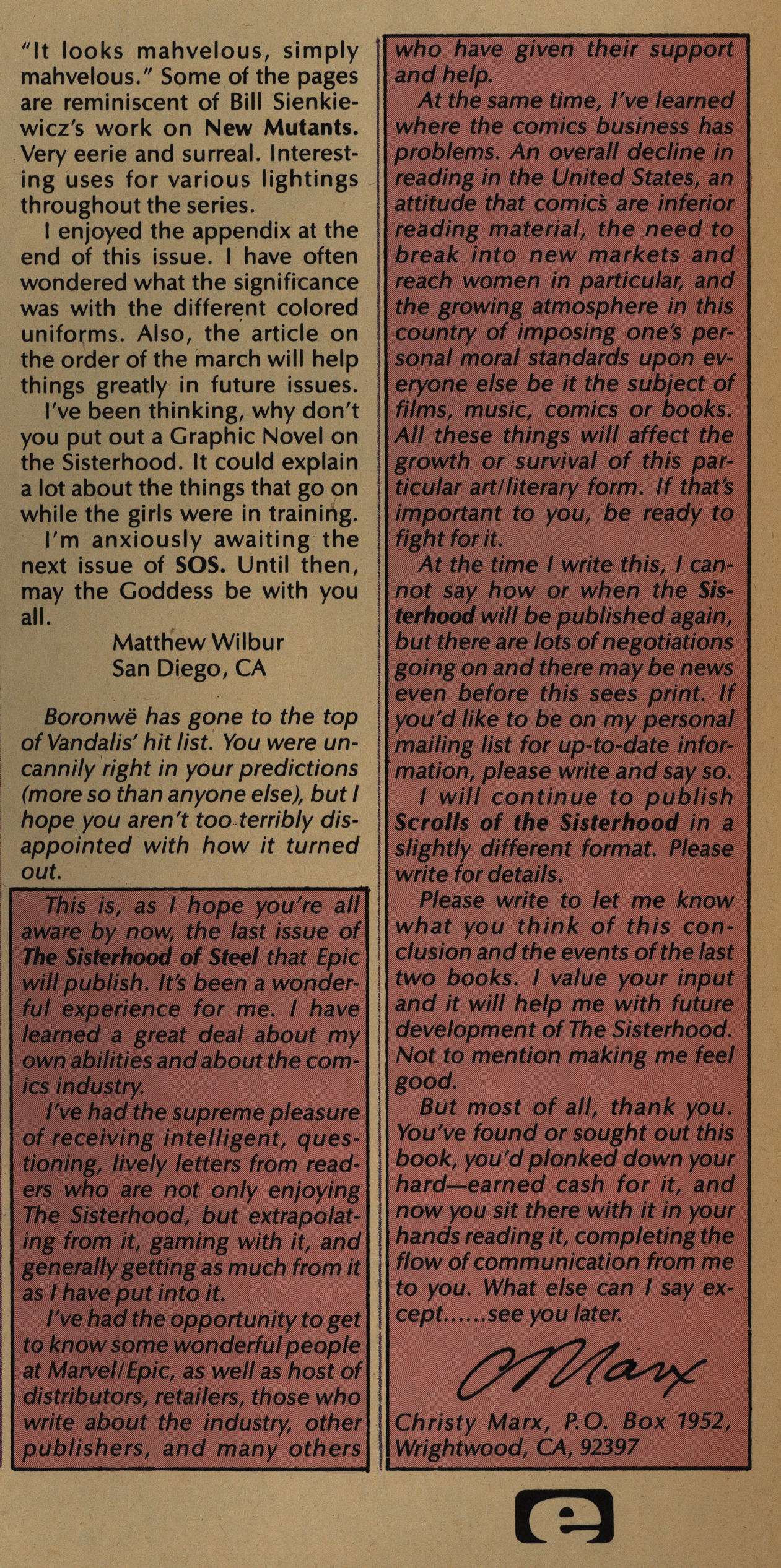Dreadstar, February 1985
1984: The Sisterhood of Steel
The Sisterhood of Steel (1984) #1-8
by Christy Marx and Mike Vosburg
I wasn’t much looking forward to reading this series, because I read the execrable later graphic novel last year.
So I was all ready to hate this thing. It starts off in a pretty typical setting for these kinds of things: At a school, but this time the pupils are warriors… and it’s well-drawn and it’s well-told.
For instance, we do get a lot of backstory into their society, but instead of doing the normal, tedious thing (either dedicating the issue to The Origin Story or having people as-you-know-Bobbing each other about the history), we get the present-day (melo)drama with scenes of the past interspersed. It’s surprising how well it works: We get just the right amount of history lessons in between the main story. Which is really entertaining, too.
Marx stresses that they intend the book to “appeal equally to male and female readers”, which you might perhaps think is a weird thing to say, but back then in the olden days, selling a book where the vast majority of the characters are female was a harder sell than it is now (in the comics market).
It’s obvious how much work Marx (and Vosburg?) has put into this universe. It’s not a complex as, say, the Starstruck universe (my next comic to read; yay), but there’s more than usual. And I love how they don’t try to put all this stuff into the comic itself, but keeps it in the backmatter.
As the issues progress, I just find myself riveted to my sofa here: It’s such a fun book to read. There’s so much going on. Each issue has 28 pages, and that really affects the pacing. They manage to give us a very satisfactory chunk every issue, with a proper storytelling arc, but it’s not an episodic book. It feels like reading a really well-developed fantasy novel.
And there’s all these little nice storytelling touches, like that gardener there being conspicuously in the foreground, letting us know that there’s a more going on here than just those two people chatting.
And there’s plenty of kick-ass action, too.
The letters pages are interesting, too. I had expected more angry fanboys, and perhaps there were, but the missives are mostly sympathetic and smart. And Marx tells the story of how she tried selling the book in a feminist bookstore.
I guess if you’re a stickler for period authenticity (I think they were going for an alternate reality Rome-ish kinda time period?), some of the scenes are perhaps less than convincing. But, hey, it’s still fun.
Oh, wow, that page looks really familiar to me. It looks really odd, too. That guy with the chin looks kinda photo-copied? Was there some controversy about it? Let’s see whether there’s anything in The Comics Journal.
It was! Chin guy totally was photocopied and flipped!
Christy Marx writes in The Comics Journal #101, page 37
A VIOLATED SISTERHOOD
CHRISTY MARX
Wrightwood CA
I enjoyed your editorial, “Intellectual Shenani-
gans,” in Journal #98.
Here’s another one. Compare the attached original
panel from The Sisterhood Of Steel to What
appeared on the stands. This was a result of
trickle;down paranoia after the infamous Moon-
shadow distributors meeting. I got a call from
Laurie Sutton the day before the issue was to
go to the printers and was told that certain things
had to be changed, This panel was one Of them,
which irritated me to no end because it was one
of the jokes of the storyline that needed to be
visual.
I also had to find alternatives to the words
“jugs,” “knockers,” ‘tits,” and “balls.” Oddly
enough, the word “shit” passed inspection. Does
this simply mean that America is more hung up
on sex than defecation?
I’m not knocking Laurie. Both she and Carol
Kalish (Marvel’s promotional director to the
direct-sales market) have been wonderful sup-
porters Of The Sisrerhood of Steel, and Laurie had
to pas along the directives she’d l*en given. Part-
ly I object to the fact that the changes were only
requested after a distributor complained about
not being warned that there was “salacious”
material in a Marvel comic… regardless Of the
Epic imprint. Somehow Epic must live up to the
safe, clean standards Of a Marvel comic.
I wasp’t happy about the ehanges. In fact, I was
fucking pissed as all hell, but made the changes
because didn’t have the time to do anything
else. I thought I was writing mature material for
a mature audience. I thought Epic Comics was
geared to that market. So fine, said, if I’m go-
ing to be placed under those kinds Of restrictions,
then why isn’t my book given newsstand distribu-
tion.’ Well, I’m told, Epic is too mature for news-
stand distribution.
Hunh?
Someone has to make up his mind. And this
idea khat putting ‘ ‘For Mature Readers” on the
cover is gping to cut back sales doesn’t ring en-
tirely true. nere are two major reasons that sales
are low-for direct-sales books: a) not enough
publicity and promotion, especially in non-comic
markets; and people don’t Where to find
khe damn things! (Nor can I offer a subscription
for The Sisterhcod Of Steel, because Epic won’t
allow one..
. and so it goes.)
Peter Ledger and I ran into a similar situation
with Eclipse on our “Carlos McLlyr the Califor-
nio” series in Eclipse Monthly. Now, I preface this
by saying that we have high regard for Cat and
Dean and have nothing but good to report in
our dealing With them. But Peter had to paint
out pussy and tits from a rape scene because
Eclipse is worried about a born-again Christian
Who is one Of the major distributors. And like
so much Of the rest Of this sexually repressed
country, the distributor chooses to force his per-
sonal moral judgments on the comics he sells.
This is a valid worry On the part of Eclipse,
who cannot afford to lose a major distributor.
What bothers me is, why are we at the mercy
of such an individual? Shouldn’t all the comic-
book companies be looking for a way to remove
such power from this person by seeking alter-
native distribution systems?
I had totally forgotten there was this much drama around the issue…
(The born-again Christian distributor she talks about is Steve Geppi, who owns Diamond Distributors, who’s the monopolistic distributor in the US now.)
ANYWAY. It turns out that the place the guy with the cod piece is attacking is… *gasp*… a lesbian bar! (Our Hero walks into it by mistake and a tense sitch happens.)
I don’t really have that much to say about this book, because there’s nothing that annoys me about it. There’s a bunch of different plots going on at the same time, but they’re handled deftly and it never feels like we’re being short-shifted on any of them. The artwork is perhaps not super-exciting (especially with the lack of backgrounds in many scenes), but it conveys all the drama superbly and manages to keep everybody looking distinct, which is a must when there are this many characters in the book.
And they wisely go for a soap-opera-with-battles-now-and-then approach to character development, and… I’m just thoroughly entertained. It’s the equivalent of watching a really well-made fantasy TV series. (Although there aren’t really many fantasy elements here.)
I don’t even mind scenes like this, where the characters are helpfully thinking thoughts that happen to fill the readers in on their dilemmas.
I’m also taken with just how well-balanced some of these scenes are. The interestingly-coloured mountains balancing out the castle; the sign post balancing out the woman; the propulsive almost-disappearing-out-of-the-frame thing…
And in general, I really enjoy looking at these colour combinations. It’s from a very limited palette, both from necessity (it’s mechanical seps) and from choice, and it just looks good. Vosburg coloured most of the issues himself, but this one is by Sue Vosburg.
Huh. Marx is thanking the associate editor out of the blue? Oh, yeah, Sutton was fired for siding with Tom Yeates in a kerfuffle over at Timespirits around this time, so I guess that’s Marx’ way of saying “goodbye”.
Heh, she started a fan club. I wonder what happened to that…
I googled, but I came up with this instead:
Friends: What was it like working with Marvel? You have any
plans for working with any of their other titles in the future?Christy: I worked with Epic and with my editor Laurie Sutton.
She was great. It went well until they censored SOS #4 and I
wrote a blistering rant about it in my Scrolls of the Sisterhood.
When the editor of the Epic line, Archie Goodwin, saw that, he
cancelled my upcoming deal to do a Sisterhood graphic novel. I
have let it be very well known in the comic trades how I felt about
that. I don’t know how Marvel would feel about giving me work.
I may still be on their s— list. I wouldn’t care to work with
Goodwin again and I imagine he feels the same.
Oops. But I can’t find anything else about the newsletter, so I guess nobody has scanned it and put it on the interwebs… Reading that rant may be fun.
Anyway! The issues continue to have these text pages explaining things about the universe.
The last two issues are mostly taken up with a trial of the main protagonist, and it hits all the notes a good trial should have (reveals and reversals), and it’s fun. However, this means that a couple of the other plots disappear almost completely… but I guess that they knew they were cancelled at this point, and wanted to bring at least one of the plots to a conclusion.
And this is how Goodwin announces that the series is cancelled.
Er uhm. Token.
And then Marx lets us know that it’s the final issue, too.
There was a graphic novel published a couple of years later (from Eclipse, and without Vosburg), and as I said at the start: It’s really bad. But these eight issues were a joy to read. Fast-paced and intriguing with pages that read well. I was at the edge of my er sofa while reading this, and that doesn’t happen often with these kinds of comics.
It’s never been reprinted, which is a shame. But it’s perhaps understandable since some of the plot lines were left dangling. It felt like they had something really solid going on: To resolve everything that had been set up, they’d have needed at least a couple dozen issues, and I’d have been totally on board for that.
The controversy about the editorial changes continued in TCJ.
Patrick Daniel O’Neill writes in The Comics Journal #109, page 40
Goodwin and Mullaney’s “stand against any
form of censorship” remains intact-it is not
censorship to make changes in your own publi-
cations Of your own volition. It is censorship
when those changes are imposed on you from
outside. Nobody told Archie or Dean that
“Stephanie Starr” or Sisterhood Of Steel had to
be changed or they couldn’t go on sale-each
man chose to ensure that the creators’ work
would reach the largest possible audience by
requesting changes that really didn’t harm the
overall integrity Of the work.
And in the final examination, the whole
argument (at least in regards to Sisterhood Of
Steel) is moot: this is not a mature, adult
fantasy creation by any stretch of the
imagination-it is puerile trash, as lacking in
meaning as any tale of Conan or Red Sonja.
Garbage wrapped in the trendy clothing Of
feminism stinks just the same.
Well! I never!
Marx responds:
I pity those poor souls Who must fall under
O’Neill’s editorial thumb A true mental giant
is he, when he is unable to distinguish the vast
differences in content and style between
Conan/Red Sonja and The Sisterhood Of Steel,
and when he is unable to distinguish a feminist
tract from something that is a fantasy adven-
ture tale that happens to fe9ture a society of
strong women.
But then, it’s easy to sling about cliche slurs
without intelligent arguments to back them
up If I really wanted to trendy, I could sure-
ly create a team Of teen-age mutants and cash
in on that. Perish the thought that should
so clearly seek my fame and fortune with
something as mainstream as The Sisterhood of
Steel.
I never wanted to make a mountain Out Of
the molehill of the changes to ‘4,
but here I am on the peak. may as well Strap
on my skis and go thundering into the abyss.
HOW blithely O’Neill Suggests that creators
not sell their work to publishers Who Will
change them. Are we clairvoyant, then?
Besides, changes are to be expected. That’s
why there are editors, to make what changes
may be needed to improve the work or keep
it up to standards. My Objection has never
been to Epic’s right to request changes, not
even so much to the changes themselves. My
objection is to the manner in which it was
done and the reasons for which it was done.
There is a clear-cut difference between
editorial changes and censorship, in this case.
Before Sisterhrxxl ever saw publication,
discussed with Laurie Sutton, the editor,
which words were and which were okay.
so that I what their editorial
were. The guidelines were somewhat vagae, but
I avoided the obviously “no-no” words, per our
agreement.
When the script for Sisterhm-d ‘4 was turned
in, Laurie called me and asked if this was as
far as intended to go With my language.
explained, yes, this was intended to be a
raunchy, cutting-loose issue and I wouldn’t
push it any further. Laurie did not ask for any
changes, either in words or images. Therefore,
the script was accepted under their editorial
standards.
It was only after the distributor’s meeting
that Laurie suddenly had to call me up again,
very reluctantly, and tell me the changes must
be made. t did not acquiesce to them. had
the choice Of making the changes myself or
letting someone else make them. True, I had
a third choice-fight the changes. at the risk
of making the terribly late for release and
creating all kinds of bad feelings. As a
Sional, I chose not to do that. Nor do think
would have won.
I know Laurie didn’t initiate the changes.
Archie Goodwin, in a later phone conversa-
tion, told me that he did. But you can bet he
didn’t initiate them Out Of the blue. There had
to be a reason and that reason brings us to
the question of censorship.[…]
This may sound like I’m coming down hard
on Archie. Let me say that I do not envy
Archie his position and I think he tried to do
some good and daring things With Epic
ics against tough Odds from within and
Without. I have my own personal gripes about
the man, but have no Wish to make him out
the villain Of the piece. had to a
large percentage of my reactions on second.
and even third-hand information, Which
always makes me nervous, nor can claim to
know what happens in Archie Goodwin’s
mind.
OK, that’s enough about the censorship drama… What did the critics think of the book?
R Fiore writes in The Comics Journal #96, page 34
In Sisterhood I
found myself wondering just whose fantasy
this is. The sisterhood ‘of the title is a
matriarchal mercenary clan on an im-
pregnable island. The only thing matriar-
chal about it is the gender of the soldiers;
the primal”/ model for the society would
seem to be the Marine Corps. Lacking the
usual means of increasing the population,
they recruit through buying
female children. While this saves the
children from the proverbial fate worse
than death, it apparently doesn’t change
their status of servitude; once a sister you
stgy a sister. Whence comes the plot con-
‘flict. the main characters are Boronwe,
butchest of the butch (though she looks
more, like a stroke-book queen on the
cover), and Kelki, her lifelong friend who
has found herself a boyfriend from off the
island and deserted. I’m no psychic, but I
this tremendous premonition that
bronwe will be seni to bring back her
backsliding pal’s head, and we’re going to
wind up with another courageous defense
of moderatiop.
Where Starstruc is a freedom fantasy,
Sisterhood is ‘a power fantasy. Most women
have been willing to ascribe the martial vir-
tues to fratriarchal societies, seeing as how
they’ve caused more misery than any other
human trait. If Sisterhood is supposed to be
a wish fulfillment it’s a strange one (sexist
society is denying women the opportunity
to be Prussians?), and if its supposed to be a
cautionary tale it’s too much of a set-up.
Look at those strawmen burn! Burn strawmen burn!
